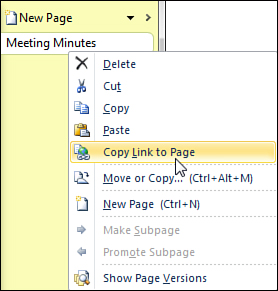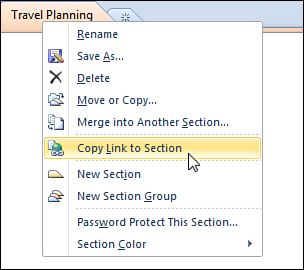Typically, links are used to
point to related information that does not need to be stored as part of
your notebook. For example, you might link to a specific Wikipedia
article that discusses something in greater detail than its brief
description in your notes.
When it comes to organizing your notes and
notebooks, however, the link functionality in OneNote offers a
convenient way to link pages, sections, and entire notebooks together.
The practical uses for this are virtually endless—from wiki creation to
giving shared notebooks a real navigation system.
For
example, corporate trainers can distribute reading materials
electronically by sharing such content in notebooks where the pages and
sections are linked for easy cross-referencing. A reader of the
notebook can easily jump to various locations in the notebook by simply
clicking the links.
The following procedures show you how you can use
the commands that OneNote provides to create navigation links to
various parts of your notebook content and how you can use the wiki
syntax while typing notes to link to existing pages and sections or to
dynamically create new pages that you want to link to.
Creating a Link to a Specific Notes Page
To create a link that will open a specific page in your notebook, follow these steps:
1. | Navigate
to the page that the link should open when it is clicked and then
right-click its page tab near the right side of the OneNote program
window.
|
2. | On the shortcut menu that appears, click Copy Link to Page (see Figure 1).

|
3. | Go to the notes page where you want the link to appear, click to activate the cursor, and then press Ctrl+V to paste the link. |
When pasting links to pages, OneNote automatically
copies the page title into the link text so you don’t have to type it
again. It also formats the link in blue, underlined text to indicate
that it is clickable.
After the link has been pasted, clicking it will
immediately open the page it points to. To return to the previous page
in your notebook, click the Back button on the Quick Access Toolbar
near the upper-right corner of the OneNote program window.
|
In addition to creating a link to any page in any of
your notebooks, you can also create a link to any specific paragraph of
text or to an object on a page. To do this, move the mouse pointer over
the text or object you want to link to and then right-click the
four-headed arrow icon that appears next to it. On the menu that
appears, click Copy Link to Paragraph. After you paste the copied link
into your notes text, clicking it takes you to that specific position
on the page where the text or object is located.
|
Creating a Link to a Specific Notebook Section
To create a link that will open a specific section in your notebook, follow these steps:
1. | Navigate to the section that the link should open when it is clicked and then right-click its section tab under the ribbon.
|
2. | On the shortcut menu that appears, click Copy Link to Section (see Figure 2).

|
3. | Go to the notes page where you want the link to appear, click to activate the cursor, and then press Ctrl+V to paste the link. |
When pasting links to sections, OneNote
automatically copies the section title into the link text so you don’t
have to type it again. It also formats the link in blue, underlined
text to indicate that it is clickable.
After the link has been pasted, clicking it
will immediately open the section it points to. To return to the
previous section in your notebook, click the Back button on the Quick
Access Toolbar near the upper-right corner of the OneNote program
window.